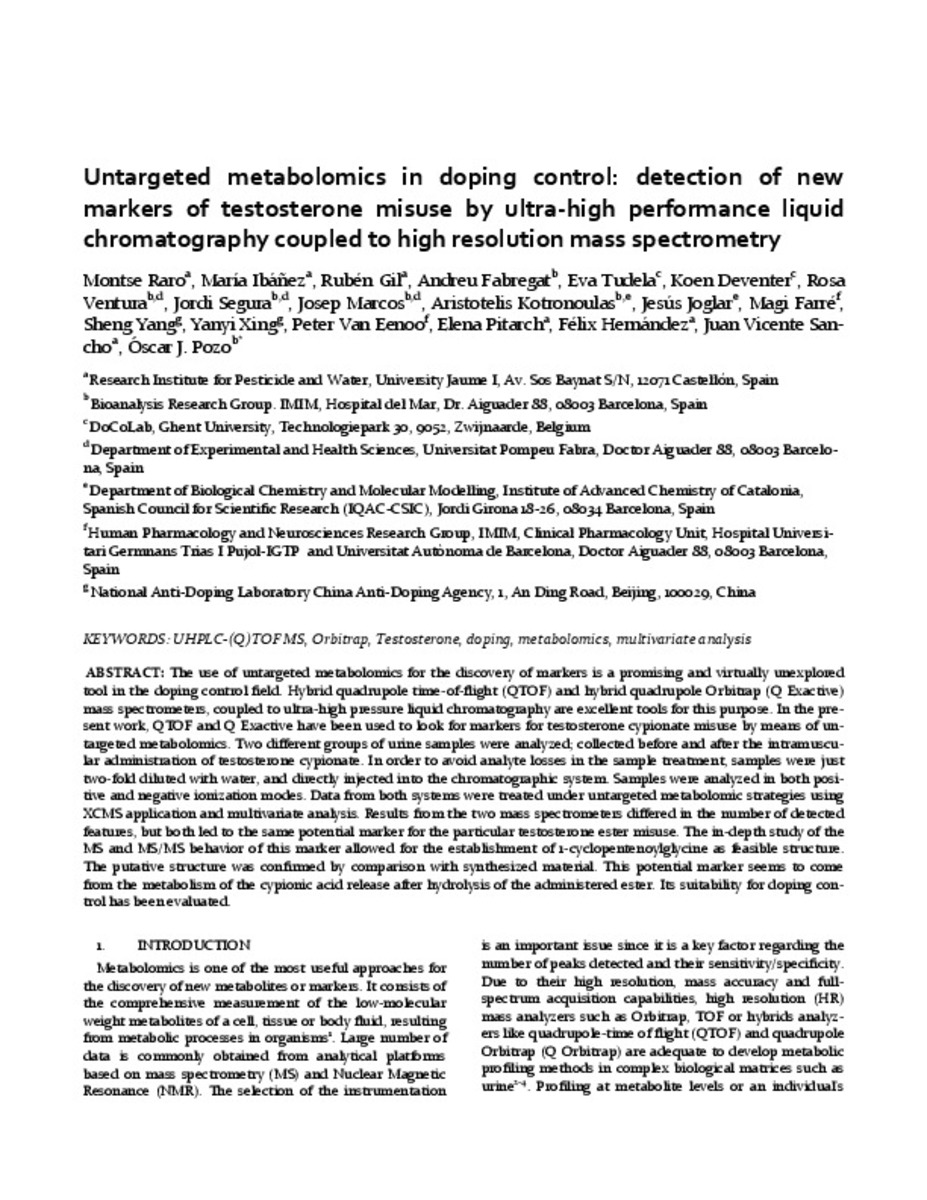Mostrar el registro sencillo del ítem
Untargeted Metabolomics in Doping Control: Detection of New Markers of Testosterone Misuse by Ultrahigh Performance Liquid Chromatography Coupled to High-Resolution Mass Spectrometry
| dc.contributor.author | Raro Macián, Montserrat | |
| dc.contributor.author | Ibáñez, Maria | |
| dc.contributor.author | Gil Solsona, Ruben | |
| dc.contributor.author | Fabregat, Andreu | |
| dc.contributor.author | Tudela, Eva | |
| dc.contributor.author | Deventer, Koen | |
| dc.contributor.author | Ventura, Rosa | |
| dc.contributor.author | Segura, Jordi | |
| dc.contributor.author | Marcos, Josep | |
| dc.contributor.author | Kotronoulas, Aristotelis | |
| dc.contributor.author | Joglar, Jesús | |
| dc.contributor.author | Farré, Magi | |
| dc.contributor.author | Yang, Sheng | |
| dc.contributor.author | Xing, Yanyi | |
| dc.contributor.author | Van Eenoo, Peter | |
| dc.contributor.author | Pitarch, Elena | |
| dc.contributor.author | Hernandez, Felix | |
| dc.contributor.author | Sancho, Juan V | |
| dc.contributor.author | Pozo, Óscar J. | |
| dc.date.accessioned | 2015-12-16T11:16:23Z | |
| dc.date.available | 2015-12-16T11:16:23Z | |
| dc.date.issued | 2015 | |
| dc.identifier.issn | 0003-2700 | |
| dc.identifier.issn | 1520-6882 | |
| dc.identifier.uri | http://hdl.handle.net/10234/143752 | |
| dc.description.abstract | The use of untargeted metabolomics for the discovery of markers is a promising and virtually unexplored tool in the doping control field. Hybrid quadrupole time-of- flight (QTOF) and hybrid quadrupole Orbitrap (Q Exactive) mass spectrometers, coupled to ultrahigh pressure liquid chromatography, are excellent tools for this purpose. In the present work, QTOF and Q Exactive have been used to look for markers for testosterone cypionate misuse by means of untargeted metabolomics. Two different groups of urine samples were analyzed, collected before and after the intramuscular administration of testosterone cypionate. In order to avoid analyte losses in the sample treatment, samples were just 2-fold diluted with water and directly injected into the chromatographic system. Samples were analyzed in both positive and negative ionization modes. Data from both systems were treated under untargeted metabolomic strategies using XCMS application and multivariate analysis. Results from the two mass spectrometers differed in the number of detected features, but both led to the same potential marker for the particular testosterone ester misuse. The in-depth study of the MS and MS/MS behavior of this marker allowed for the establishment of 1-cyclopentenoylglycine as a feasible structure. The putative structure was confirmed by comparison with synthesized material. This potential marker seems to come from the metabolism of the cypionic acid release after hydrolysis of the administered ester. Its suitability for doping control has been evaluated. | ca_CA |
| dc.description.sponsorShip | Ministry of Education and Science, Spain: DEP2011-‐28573-‐C02-‐01/02; WADA: project 14A29OP; Generalitat Valenciana: Prometeo/2009/054; PrometeoII/2014/023; ISIC EnviFood 2012/016 | ca_CA |
| dc.format.mimetype | application/pdf | ca_CA |
| dc.language.iso | eng | ca_CA |
| dc.publisher | American Chemical Society | ca_CA |
| dc.relation.isPartOf | Analytical Chemistry , vol. 87. núm. 16 | ca_CA |
| dc.rights.uri | http://rightsstatements.org/vocab/CNE/1.0/ | * |
| dc.subject | UHPLC-‐(Q)TOF MS | ca_CA |
| dc.subject | Orbitrap | ca_CA |
| dc.subject | Testosterone | ca_CA |
| dc.subject | doping | ca_CA |
| dc.subject | metabolomics | ca_CA |
| dc.subject | multivariate analysis | ca_CA |
| dc.title | Untargeted Metabolomics in Doping Control: Detection of New Markers of Testosterone Misuse by Ultrahigh Performance Liquid Chromatography Coupled to High-Resolution Mass Spectrometry | ca_CA |
| dc.type | info:eu-repo/semantics/article | ca_CA |
| dc.identifier.doi | http://dx.doi.org/10.1021/acs.analchem.5b02254 | |
| dc.rights.accessRights | info:eu-repo/semantics/openAccess | ca_CA |
| dc.relation.publisherVersion | http://pubs.acs.org/doi/pdf/10.1021/acs.analchem.5b02254 | ca_CA |
| dc.edition | postprint del autor | ca_CA |
| dc.type.version | info:eu-repo/semantics/acceptedVersion |
Ficheros en el ítem
Este ítem aparece en la(s) siguiente(s) colección(ones)
-
IUPA_Articles [306]







